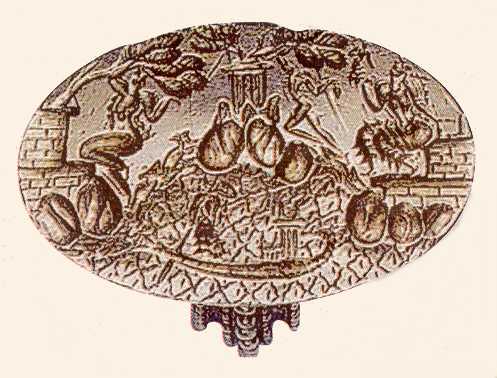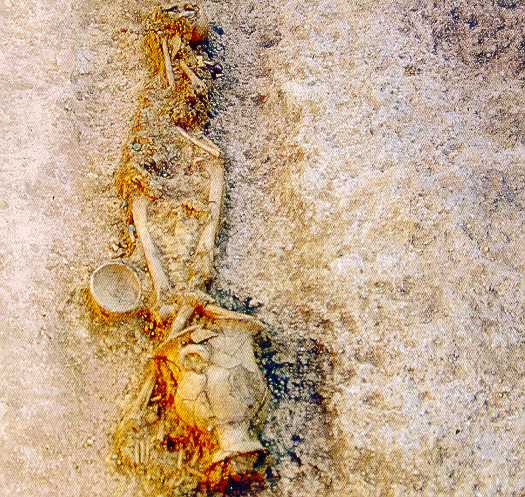
ANISTORITON
Issue A031 of 15 March 2003
http://users.hol.gr/~dilos/anistor/cover.htm
Minos's Ring is Finally Accepted as Authentic
 In 1928 a Greek farmer found in his field near Minoan Knossos a gold ring that was nicknamed Minos's ring. He immediately understood that it was of ancient made and handed it in to the Greek Archaeological service. However, there was no agreement among the archaeologists on the authenticity of the ring. Arthur Evans (excavator of Knossos) and N. Platon (excavator of Zakros) believed that it really dated to the Minoan times but Sp. Marinatos (excavator of Thera) believed that it was a fake. As Marinatos became extremely influential among the Greek archaeologists in the post World War II period, the ring was eventually discarded and the whole story was forgotten.
In 1928 a Greek farmer found in his field near Minoan Knossos a gold ring that was nicknamed Minos's ring. He immediately understood that it was of ancient made and handed it in to the Greek Archaeological service. However, there was no agreement among the archaeologists on the authenticity of the ring. Arthur Evans (excavator of Knossos) and N. Platon (excavator of Zakros) believed that it really dated to the Minoan times but Sp. Marinatos (excavator of Thera) believed that it was a fake. As Marinatos became extremely influential among the Greek archaeologists in the post World War II period, the ring was eventually discarded and the whole story was forgotten.
In 2001, Mr G. Kazantzis inherited a house in Crete and when he visited the building he found Minos's ring to be part of the fireplace. He detached it from the fireplace wall and handed it in to the Greek Archaeological Service once more. This time the ring was examined by the Central Archaeological Board of Greece and was found to be authentic. Thus, according to Greek law, Mr. Kazantzis received the finder's reward of 400.000 Euros.
Why were there doubts about the authenticity of Minos's ring some eighty years ago but nowadays none? The ring is in perfect condition as if it was just made. The scene that is incised on its flat face is extremely rare and unusual: a sitting goddess on the right, dancers or demons worshipping trees (dendrolatria), tree fruits, and at the bottom, the sea and a boat in the form of a sea horse (hippocampus). Until the late 20th century there has been no similar iconography from Minoan sites, a fact that justifies the original opinion split. However, nowadays, in the light of the wealth of recent minoan times findings, archaeologists are certain that it is a 15th c. BCE ring.
Hellenistic Graves in Mountainous Pieria
 Pella, Pydna, Methoni, and Dion are well known lowland centers in Macedonia, inhabited by generally wealthy and well to do families in the Hellenistic era. New excavation in the mountainous areas of the region and specifically in Pieria proved that some well to do families preferred to live and die in higher places compared to their compatriots.
Pella, Pydna, Methoni, and Dion are well known lowland centers in Macedonia, inhabited by generally wealthy and well to do families in the Hellenistic era. New excavation in the mountainous areas of the region and specifically in Pieria proved that some well to do families preferred to live and die in higher places compared to their compatriots.
In the area of the modern village Kolindros, Pieria, Greece, archaeologists found about thirty graves of men, women, and children dating between 350 and 130 BCE. They contained weapons, jewelry, vases, coins, items that prove that their owners were at least of a middle class, financially wise.
 Back to Cover
Back to Cover
 In 1928 a Greek farmer found in his field near Minoan Knossos a gold ring that was nicknamed Minos's ring. He immediately understood that it was of ancient made and handed it in to the Greek Archaeological service. However, there was no agreement among the archaeologists on the authenticity of the ring. Arthur Evans (excavator of Knossos) and N. Platon (excavator of Zakros) believed that it really dated to the Minoan times but Sp. Marinatos (excavator of Thera) believed that it was a fake. As Marinatos became extremely influential among the Greek archaeologists in the post World War II period, the ring was eventually discarded and the whole story was forgotten.
In 1928 a Greek farmer found in his field near Minoan Knossos a gold ring that was nicknamed Minos's ring. He immediately understood that it was of ancient made and handed it in to the Greek Archaeological service. However, there was no agreement among the archaeologists on the authenticity of the ring. Arthur Evans (excavator of Knossos) and N. Platon (excavator of Zakros) believed that it really dated to the Minoan times but Sp. Marinatos (excavator of Thera) believed that it was a fake. As Marinatos became extremely influential among the Greek archaeologists in the post World War II period, the ring was eventually discarded and the whole story was forgotten. Pella, Pydna, Methoni, and Dion are well known lowland centers in Macedonia, inhabited by generally wealthy and well to do families in the Hellenistic era. New excavation in the mountainous areas of the region and specifically in Pieria proved that some well to do families preferred to live and die in higher places compared to their compatriots.
Pella, Pydna, Methoni, and Dion are well known lowland centers in Macedonia, inhabited by generally wealthy and well to do families in the Hellenistic era. New excavation in the mountainous areas of the region and specifically in Pieria proved that some well to do families preferred to live and die in higher places compared to their compatriots.